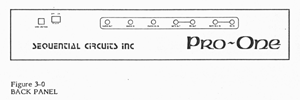 Fig
3-0
Fig
3-0[The Sequential Circuits Pro-One Annotated Manual]
[Annotations in bold square brackets by
jet.]
[Scanned from a photocopy of the original. Original format retained
wherever possible.]
[Modified or replaced graphics noted as such.]
|
SECTION 3 |
BACK PANEL |
|
|
3-0 |
23 | |
|
3-1 |
23 | |
|
3-2 |
23 | |
|
3-3 |
24 | |
|
3-4 |
24 | |
|
3-5 |
24 | |
|
3-6 |
24 |
[Page 23]
This section describes all connections which may be made via the back panel jacks. Except for AUDIO OUT, all jacks accept a standard 1/4" mono phone plug. (The digital interface is described in paragraph 5-6.)
This jack allows an external audio input to be mixed and processed by the Pro-One's filter and amplifier. The input drives an internal envelope detector which generates a GATE once the input level has passed the threshold set by the MIXER NOISE/EXT knob. The GATE which is produced controls the filter and amplifier envelope generators. This GATE can also advance the arpeggiator or sequencer when these keyboard controls are selected. It overrides both the LFO/CLOCK and the GATE/CLK IN input (see below).
To enable the gate generator, REPEAT/EXT MODE must be selected. The input is very sensitive, being drivable by a microphone or electric guitar pickup. Line-level audio can overdrive the input. The principle for correct adjustment of the GATE generator is to set the MIX NOISE/ XT knob at the minimum level necessary for consistent or adequate gating. Observe the GATE LED for aid in adjustment.
This jack accepts 0-10 Vdc, usually provided by a voltage pedal for control of the filter cutoff frequency at a scale of [V/octave. When connected, this CV overrides the normal KYBD CV, but may still be attenuated with the FILTER KEYBOARD AMOUNT knob.
CM 100 2/81
This digital signal follows the GATE status as indicated by the GATE LED. That is, whenever a note is played on the keyboard or by the arpeggiator or sequencer in playback, GATE OUT will be high (+5V-nominal).
This jack makes the [V/octave KYBD CV available for control of external equipment. It basically ranges 0.083V to 3.083V (three octaves), following the keyboard or sequencer. If the sequencer is transposed (see paragraph 1-6), CV OUT can range -1V to 4V.
Once this digital input is enabled by selecting the REPEAT/EXT MODE, it provides for envelope gating, or sequencer or appegiate clocking by an external (+5Vnominal) pulse.
This jack accepts 0-10 Vdc for control of the oscillators and filter at a scale of [V/octave. Similarly to the FILTER CV IN jack, when connected, CV IN overrides the normal KYBD CV, but may still be switched by the OSC B KYBD switch and attenuated by the FILTER KEYBOARD AMOUNT knob. (For the FILTER, FILTER CV IN overrides CV IN.)
If your sound disappears when you connect to this input, you may be driving the oscillators into the superaudio range. Reducing the external CV will return the oscillator frequencies to the range of human hearing.
CM 100 2/81